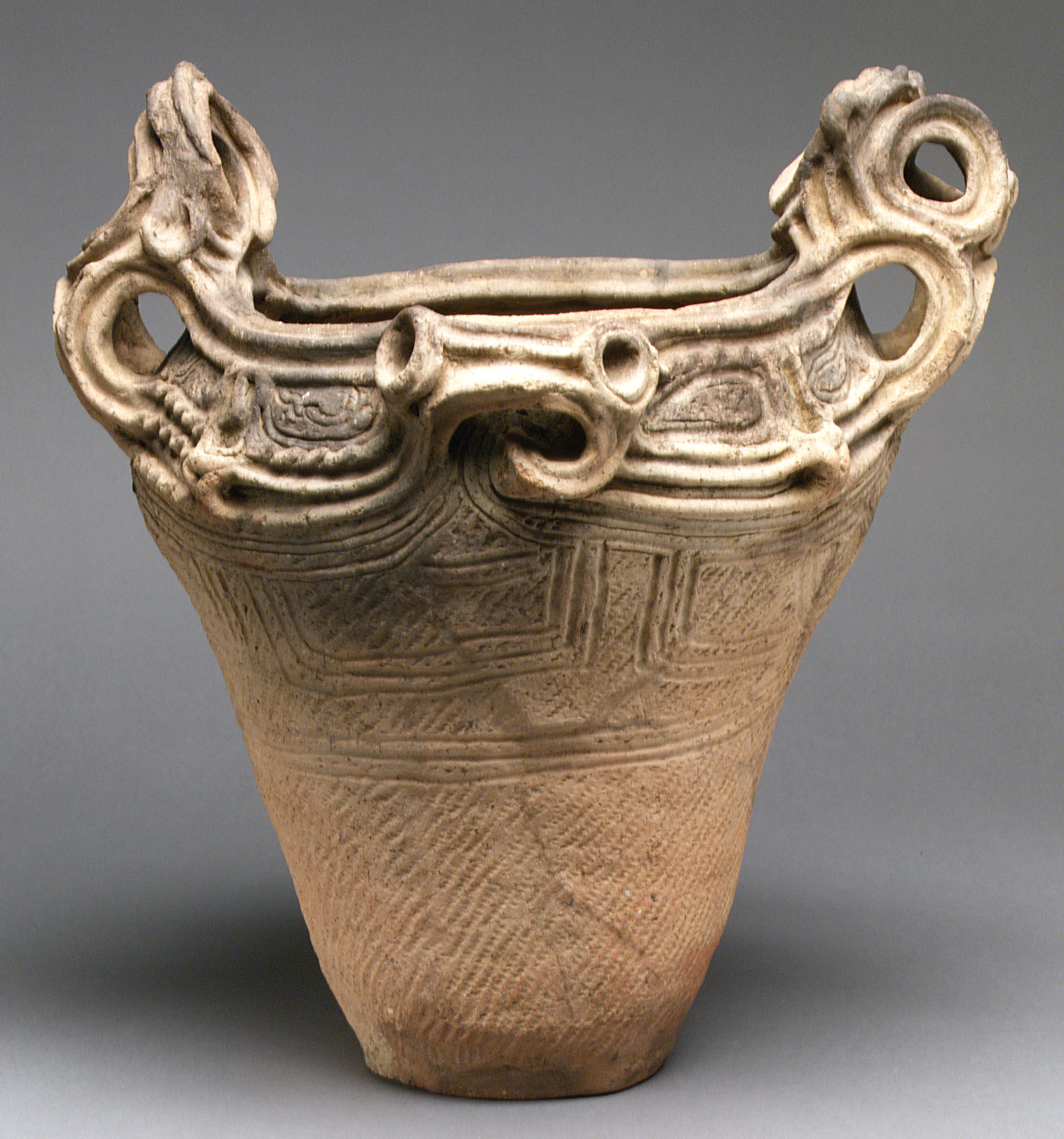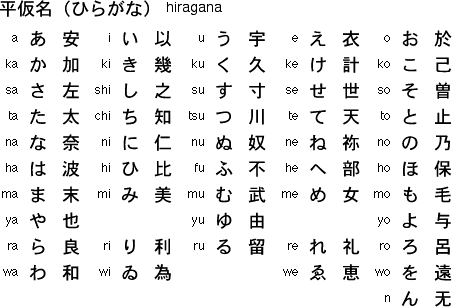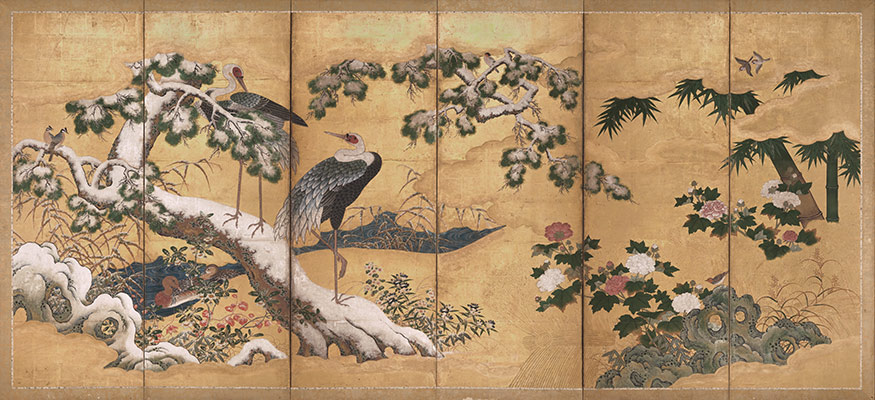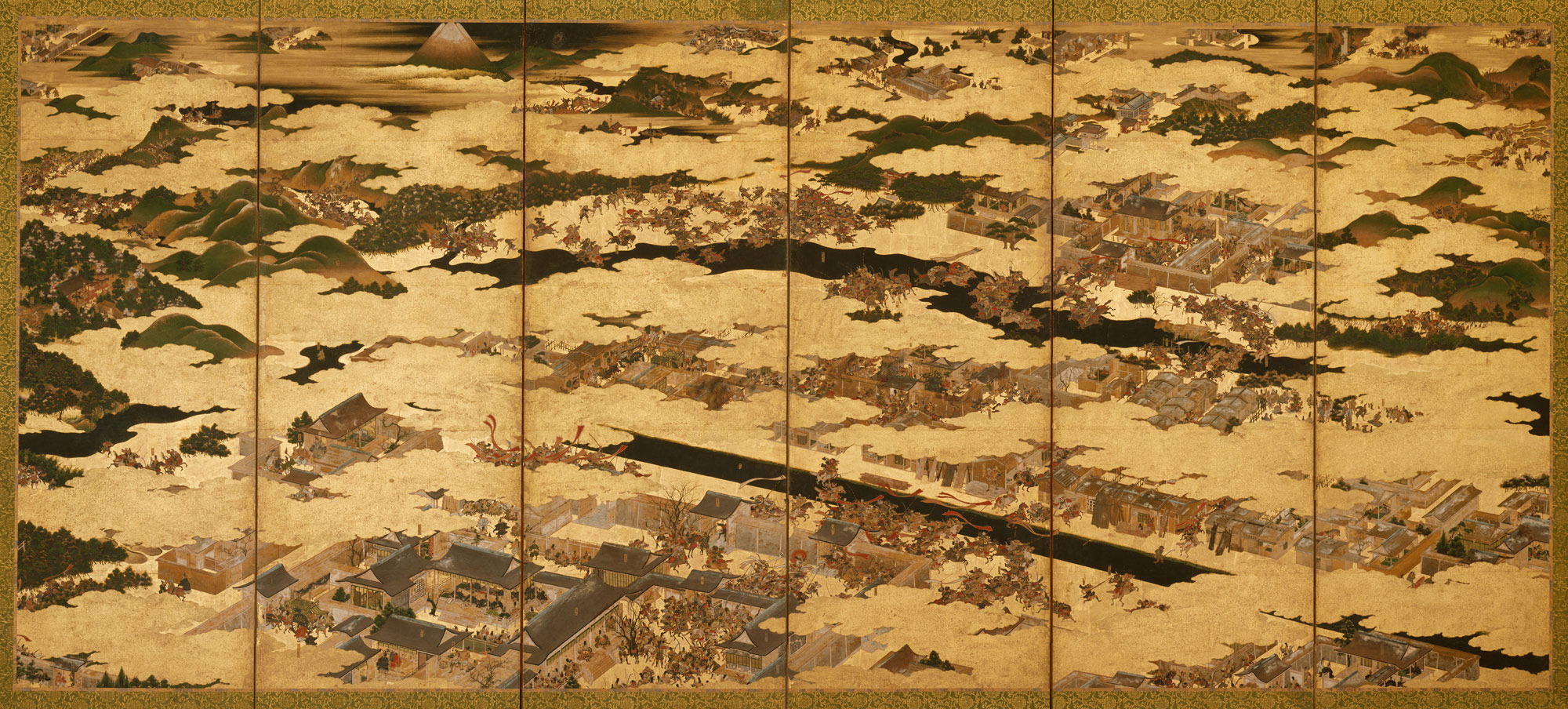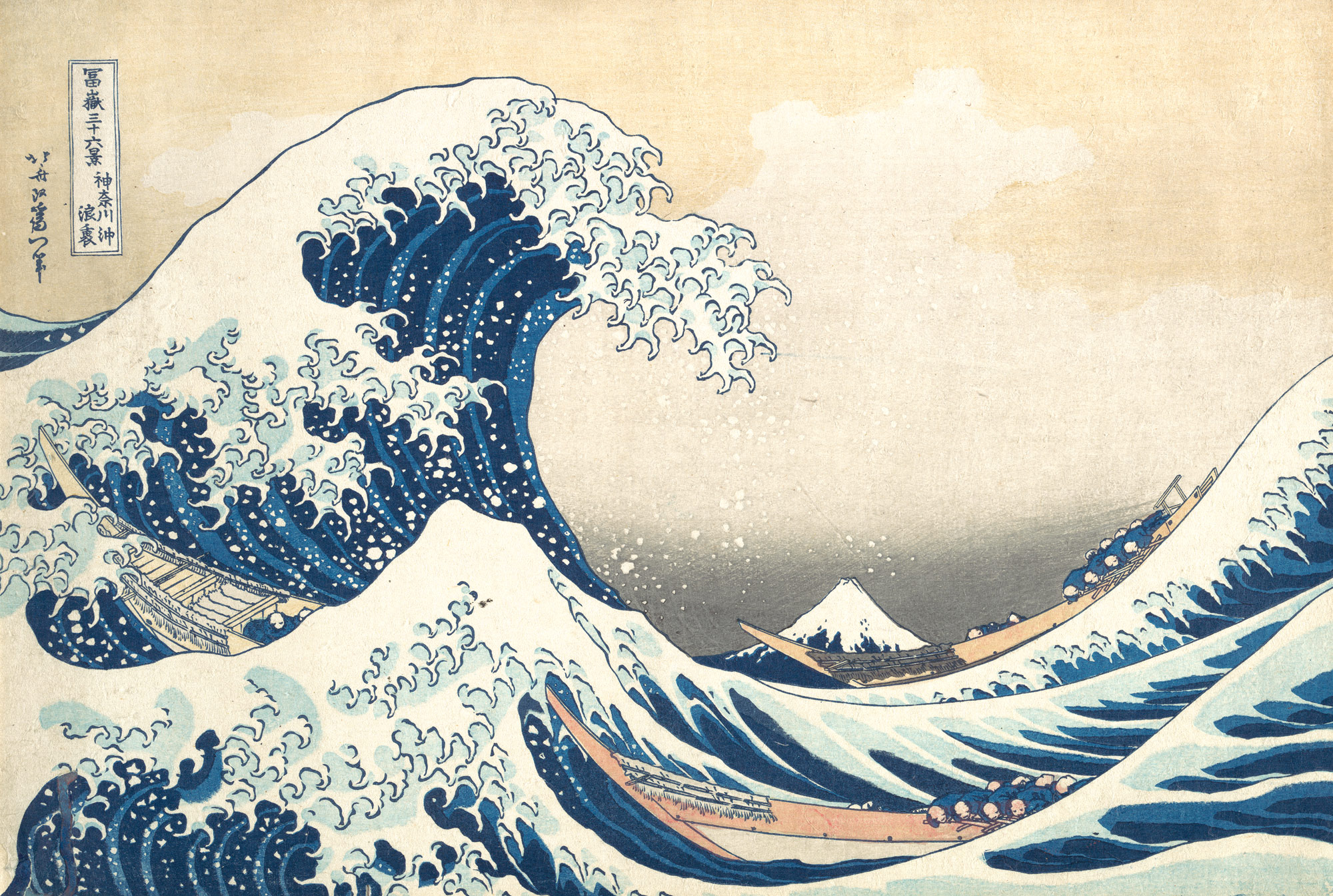Formative Period (c.11000-300BC)
The Formative period is separated into three stages: Jomon, Yayoi and Kofun art.
Jomon art
The Jomon people were the first settlers of Japan and lived between the years 11000 - 300BC. Like most people of the Neolithic era, the Jomon people were a hunter and gatherer nomads who eventually settled and began farming and building cities.
The Jomon Period is divided into six periods:
Incipient Jomon from 10500 - 8000BC
Earliest Jomon from 8000 - 5000BC
Early Jomon from 5000 - 2500BC
Middle Jomon from 2500 - 1500BC
Late Jomon from 1500 - 1000BC
Final Jomon from 1000 - 300BC.[2]
The unique patterns on these early pottery were made by pressing rope into the clay before firing. The early pottery of the Incipient Jomon period have pointed bottoms, crude rope markings. indicating that it was mostly used to boil food over a fire. Around the Middle Jomon period, the pottery became more decorative and complex.
Dogu Figurines, "Venus Figure"
second to right [9]
|
From the Middle Jomon period to the Late Jomon period, small humanoid figurines called Dogu were produced prolifically. The earliest known Dogu found is from the Incipient Jomon period. Most Dogu depict pregnant women, an iconic examples is the Jomon Venus figurine, and are typically found broken into pieces. Scholars believe the figurines were used in ceremonious cleansing rituals or as charms used to call upon the gods. Other styles include animal shapes and slit-goggled figurines.[3]
Yayoi art
Yayoi Jar [10]
|
Dotaku Bells[11]
|
Most weapons, tools and armor were cast from bronze and iron during the Yayoi period, including richly decorated bells called dotaku. It is believed they were used in rituals and as emergency bells to alert residents and warriors of invasion. Dotaku are typically a truncated cone shape with an oval shaped top and is banded with horizontal rows intersected by central vertical rows. The bells have a large arching flange that extends over the top and sides of the body.[5]
decorated in hatched lines, triangles, spirals and geometric patterns.
Kofun art
Kofun art
Daisen Kofun, Sakai, Osaka Prefecture [12]
|
The Konfun period lasted from 250 to 538 AD. It's characterized by burial mounds called kofun, which gave this era its name. Buried around the kofun were unglazed pottery called heiji ware and sue ware, bronze mirrors and figurines called haniwa.[6]
Konfun period pottery is divided into two categories: heiji ware and sue ware. Heiji ware was a utilitarian ware with a redish-yellow color. Sue war was expensive grey ware often used in rituals.[6]
Haniwa Figurines [13]
|
Haniwa were used as grave offerings and came in many different animal forms, objects such as pillows and human figures.[6] Scholars believe they were used as boundary markers for burial mounds and were considered containers for souls. They are often depicted with armor and weapons which may have been intended to "drive-away" evil spirits.
Magatama bead, Final Jomon era [7]
|
The elites from the Yamato court often wore special comma-shaped beads called magatama as funerary objects.[6] While magatama can be found as early as the Final Jomon period, they became increasingly popular during the Kofun period. Ealry magatama were made from simple materials such as clay, quartz, and slate. They became more refined and polished during the Yayoi period and were made from gemstones, such as jadedite and seroentinite, and glass. The beads were often made into necklaces, bracelets and anklets and over time became a status symbol for the elite.[7] During the Kofun period, magatama were very common and were buried in almost all kofun. At the height of their popularity, they were made of jadedite, jasper, agate and jade. Some were even capped in silver or gold.[8] Over time they went from decorative jewelry to sacred ceremonial funerary goods. Most haniwa depicted people wearing the beads as necklaces or anklets. Magatama shaped symbols can even be found in modern day Japanese art.
References:
[1] Craig, O.E., Saul, H., Lucquin, A., Nishida, Y., Taché, K., Clarke, L., Thompson, A., Altoft, D.T., Uchiyama, J., Ajimoto, M., Gibbs, K., Isaksson, S., Heron, C.P. and Jordan, P. (2013) ‘Earliest evidence for the use of pottery’, Nature, 496(7445), pp. 351–354. doi: 10.1038/nature12109.
[2] Jomon culture (ca. 10, 500–ca. 300 B.C.) | essay | Heilbrunn Timeline of art history | the metropolitan museum of art (2000) Available at: http://www.metmuseum.org/toah/hd/jomo/hd_jomo.html.
[3] Kawagoe, A. (2007) Jomon Dogu: The mystery of the broken Clay Dolls. Available at: https://heritageofjapan.wordpress.com/just-what-was-so-amazing-about-jomon-japan/ways-of-the-jomon-world-2/jomon-crafts-and-what-they-were-for/the-mystery-of-the-clay-dolls/
[4] Yayoi culture (ca. Fourth century B.C.–Third century A.D.) | essay | Heilbrunn Timeline of art history | the metropolitan museum of art (2000) Available at: http://www.metmuseum.org/toah/hd/yayo/hd_yayo.html
[5] Dōtaku (bronze bell) | work of art | Heilbrunn Timeline of art history | the metropolitan museum of art (2000) Available at: http://www.metmuseum.org/toah/works-of-art/18.68/
[6] Keally, C. (2009) Kofun Culture. Available at: http://www.t-net.ne.jp/~keally/kofun.html
[7] The Pitt Rivers Museum, University of Oxford (no date) Small blessings - Magatama, Japan. Available at: http://web.prm.ox.ac.uk/amulets/index.php/protection-8/
[8] The Editors of Encyclopædia Britannica (1998) ‘Magatama | jade ornament’, in Encyclopædia Britannica. Available at: https://www.britannica.com/art/magatama
[9]Metropolis, W. to F. (no date) Metropolis. Available at: http://metropolisjapan.com/ (Accessed: 23 February 2017).
[10]Boundless (2016) Ceramics and bronze in the Yayoi period. Available at: https://www.boundless.com/art-history/textbooks/boundless-art-history-textbook/japan-before-1333-ce-15/prehistoric-japan-102/ceramics-and-bronze-in-the-yayoi-period-474-6123/ (Accessed: 23 February 2017).
[11] National Museum of Japanese History (2006) The World of Dotaku" (Ceremonial Bronze Bells). Available at: https://www.rekihaku.ac.jp/english/outline/publication/rekihaku/121/witness.html (Accessed: 23 February 2017).
[12]OSAKA CONVENTION & TOURISM BUREAU (no date) Daisenryo Kofun (Emperor Nintoku’s tomb). Available at: http://www.osaka-info.jp/en/facilities/cat17/post_238.html (Accessed: 23 February 2017).
[13]Ningyozuka (no date) Available at: http://archaeology.jp/sites/2007/ningyo.htm (Accessed: 23 February 2017).
Asuka and Nara Period (c.538-710AD)
The Asuka and Nara periods were named based on the location of the government at the time.[14] The Asuka period lasted from 538 to 710 AD when the government was located in the Asuka Valley. The Nara period followed and lasted from 710 to 794AD when the government was located in Nara. The arrival of Buddhism during these periods brought significant changes to Japanese culture including social, political and artistic customs. There were two stages of Buddhist art during this time, Tori Style and Hakuho culture.
Sculpture
Kundra Kannon [15]
|
Shaka Triad [15]
|
Painting
Takamatsu tumulus wall painting[17]
|
The Hakuho culture is also known as the Taika reforms. The murals of the Golden Hall (kando) are excellent examples of this painting style. Multiple layers of plaster were applied to the wall and were then punctured to make a sketch, or cartoon, of the design. An outline of the design was made by pouring colored sand into the punctured holes. Distinct characteristics of this style include the use of red outlines instead of black and consistent line art known as "iron-wire."[17]
References:
References:
[14]The Editors of Encyclopædia Britannica (1998) ‘Nara period | Japanese history’, in Encyclopædia Britannica. Available at: https://www.britannica.com/event/Nara-period (Accessed: 23 February 2017).
[15]The Editors of Encyclopædia Britannica (2011) ‘Tori style | Japanese sculpture’, in Encyclopædia Britannica. Available at: https://www.britannica.com/art/Tori-style (Accessed: 23 February 2017).
[16]The Editors of Encyclopædia Britannica (1999) ‘Archaic smile | Greek sculpture’, in Encyclopædia Britannica. Available at: https://www.britannica.com/art/Archaic-smile (Accessed: 23 February 2017).
[17]Kawagoe, A. (2009) The art of Asuka. Available at: https://heritageofjapan.wordpress.com/inception-of-the-imperial-system-asuka-era/the-cultural-heritage-the-art-of-asuka/ (Accessed: 23 February 2017).
Literature and Paintings
Poetry grew as literacy became more common and was a marker of status. It was expected that nobles in court life were experienced at writing poetry to maintain their reputation. It was believed that the quality of a person's calligraphy was reflective of their soul, and poorly written characters were considered low class. The modern national anthem of Japan, Kimigayo, was written during this time, as well as many well-known works such as Iroha whose author's unknown.[21]
Beauty
[15]The Editors of Encyclopædia Britannica (2011) ‘Tori style | Japanese sculpture’, in Encyclopædia Britannica. Available at: https://www.britannica.com/art/Tori-style (Accessed: 23 February 2017).
[16]The Editors of Encyclopædia Britannica (1999) ‘Archaic smile | Greek sculpture’, in Encyclopædia Britannica. Available at: https://www.britannica.com/art/Archaic-smile (Accessed: 23 February 2017).
[17]Kawagoe, A. (2009) The art of Asuka. Available at: https://heritageofjapan.wordpress.com/inception-of-the-imperial-system-asuka-era/the-cultural-heritage-the-art-of-asuka/ (Accessed: 23 February 2017).
Heian Period (c.794-1185AD)
The Heian period lasted from 794 to 1185 AD and is known as the end of "classical" Japanese history. This period was named after the city Heian-kyo, the capital at the time, which was later renamed Kyoto.[18] It is during the Heian period that the influences of Buddhism, Taoism and other Chinese styles were most prominent.
Esoteric Buddhism and Mandalas
Tibetan Monks creating a mandala [19]
|
Exclusive sects of Buddhism which were common during this period were Tendai and Shingon Buddhism. They are both known by their elaborate and formal rituals.[18] Among their striking collection of calligraphy, poetry, sculptures and paintings, one symbol made famous during this time was mandalas. Mandalas are circular spiritual symbols still used in rituals today that represent the universe. They are most known for their intricate geometric designs and were used by Buddhist priests to aid in meditation. Mandalas are made by layering colored sand using a special tool that only dispenses a few grains of sand at a time. Most mandalas take weeks to complete and after they finish and pray, the priests will wipe it away as symbolism of impermanence.[19]
Literature and Paintings
Katakana Characters [20]
|
While Chinese was the official written language of the period, the introduction of kana promoted a height in literature and poetry. Kana are the Japanese scripts used in Japan's writing system. They include hiragana, katakana and kanji. Hiragana is a cursive-like alphabet used for the standard Japanese language. Katakana is a similar alphabet to hiragana but it is used for "foreign" words.[20] Kanji is the Chinese characters assimilated into the Japanese written language, however Japanese kanji and Chinese characters (hanzi) do not always correlate to the same meaning or sound.
Hiragana Characters [20]
|
Poetry grew as literacy became more common and was a marker of status. It was expected that nobles in court life were experienced at writing poetry to maintain their reputation. It was believed that the quality of a person's calligraphy was reflective of their soul, and poorly written characters were considered low class. The modern national anthem of Japan, Kimigayo, was written during this time, as well as many well-known works such as Iroha whose author's unknown.[21]
Beauty
Blackened Teeth [22]
|
The Heian period empathized beauty which was considered indicative of a person's character. It was often considered a requirement to take part in the beauty standards of the time,[22] including ohaguro(dying teeth black), powdered faces, goatees, red painted lips and the process of plucking one's eyebrows and redrawing them higher on the head.
References:
[18] The Editors of Encyclopædia Britannica (2010) ‘Heian period | Japanese history’, in Encyclopædia Britannica. Available at: https://www.britannica.com/event/Heian-period (Accessed: 23 February 2017).
[19] Exotic India (2004) The Buddhist Mandala - sacred geometry and art. Available at: http://www.kheper.net/topics/Buddhism/mandala.html (Accessed: 23 February 2017).
[20] The Editors of Encyclopædia Britannica (2016) ‘Kana | Japanese writing’, in Encyclopædia Britannica. Available at: https://www.britannica.com/topic/kana (Accessed: 23 February 2017).
[21] Asia for Educators, (2009) Literature of the Heian period: 794-1185. Available at: http://afe.easia.columbia.edu/special/japan_600ce_heian.htm (Accessed: 23 February 2017).
[22] Szczepanski, K. (2016) Beauty in Heian Japan, 794 - 1185 CE Japanese court ladies’ hair and makeup. Available at: http://asianhistory.about.com/od/japan/a/HeianBeauty.htm (Accessed: 23 February 2017).
Kamakura Period (c.1185-1333AD)
References:
Kamakura Period (c.1185-1333AD)
The Kamakura period lasted from 1185 to 1333 AD and was led by the Kamakura shogunate. This period is famously known for the rise of samurais, feudalism and the warrior caste. Buddhism was still a strong influence on Japanese culture and the two more prominent sects during this period were Zen Buddhism and Pure Land Buddhism.[23]
Sculpture
Miroku, Unkei [25]
|
Amida Triad, Kaikei[26]
|
The Kei School was a Japanese school for Buddhist sculpture which ran from the late Heian period through the Edo period.[24] During the Kamakura period, a famous sculptist from this school, Busshi Unkei, introduced a highly realistic art style through his Buddhist figures.[25] His work featured fleshed out bodies, expressive and plump faces, masculine overtones and often the use of crystals for eyes. Busshi Kaikei, Unkei's successor is credited with one of the most famous sculptures of this period, Amitabha Triad in Jodo-ji in Ono.[26]
Painting
Painting
Portrait of Minamoto no Yoritomo,
Fujiwara no Takanobu [27]
|
The Kamakura period continued the painting traditions of the Heian period. However, a key feature of the Kamakura period paintings was the realistic character portraits. Some of these portraits are known as Nise-e which were sketch-like portraits of nobility.[27] Most of the paintings were inspired by religion and their principal styles included soft landscape elements and a "blue-green style." Decorative painted sliding doors (fusuma) were popular, as well as long scrolls called emaki. These scrolls typically depicted historical events, religious rituals or legends from novels.[23]
References:
[23] Boundless (2016) Japanese painting and sculpture in the Kamakura period. Available at: https://www.boundless.com/art-history/textbooks/boundless-art-history-textbook/japan-before-1333-ce-15/the-kamakura-period-107/japanese-painting-and-sculpture-in-the-kamakura-period-483-1914/ (Accessed: 23 February 2017).
[24] JAANUS and Japanese Architecture and Art Net Users System (2001) Keiha 慶派. Available at: http://www.aisf.or.jp/~jaanus/deta/k/keiha.htm (Accessed: 23 February 2017).
[25] Schumacher, M. (2008) Unkei Busshi, Kamakura era, One of Japan’s most acclaimed sculptors of Buddha statues. Available at: http://www.onmarkproductions.com/html/busshi-buddha-sculptor-unkei-japan.html (Accessed: 23 February 2017).
[26] Schumacher, M. (2012) Kaikei Busshi, Kamakura era, One of Japan’s most acclaimed sculptors of Buddha statues. Available at: http://www.onmarkproductions.com/html/busshi-buddha-sculptor-kaikei-japan.html (Accessed: 23 February 2017).
[27] The Virtual Museum of Traditional Japanese Arts (no date) Overview of Painting of The Kamakura Period (1185-1333). Available at: http://web-japan.org/museum/painthist/phkamaj/phkamaj.html (Accessed: 23 February 2017).
Chinese imported paintings were highly influential during this time. Both the subject and general color schemes of traditional Japanese art were shifted towards Chinese styles. Chinese techniques and themes, combined with Zen Buddhism, contributed to this new style. Ink was more commonly used where previously is was reserved for religious works.[29]
References:
Muromachi Period (c.1336-1573AD)
The Muromachi period (1336 to 1573AD) is also known as the Ashikaga period and began following the Kenmu Restoration from 1333 to 1336AD. The Kenmu Restoration was an attempt to bring the Imperial house back into power, however the Ashikaga shogunate eventually took over.[28] Zen Buddhism came back to popularity for a second time during the Muromachi period.
Paintings
 |
| Birds and Flower Cho'oku Joki [29] |
Paintings from the Muromachi period are known for their realism and nature focused subjects. Bird and flower paintings were particularly popular and used bright colors or light colors combined with ink.
References:
[28] JREF (2016) History - Kemmu restoration. Available at: https://www.jref.com/articles/kemmu-restoration.277/ (Accessed: 23 February 2017).
[29] Society, A. (2007) ASIA SOCIETY: THE COLLECTION IN CONTEXT. Available at: http://asiasociety.org/museum/collection_media/h640/imported/1979.211-view-a.jpg (Accessed: 23 February 2017).
References:
References:
References:
[29] Society, A. (2007) ASIA SOCIETY: THE COLLECTION IN CONTEXT. Available at: http://asiasociety.org/museum/collection_media/h640/imported/1979.211-view-a.jpg (Accessed: 23 February 2017).
Azuchi-Momoyama Period (c.1573-1600AD)
The Azuchi–Momoyama period was the final phase of the "Sengoku" period in Japan, a time of social upheaval. It spans from 1573 to 1600. During this time Oda Nobunaga and Toyotomi Hideyoshi tried to regain order of the country after the fall of the Ashikaga shogunate.[30]
Paintings
Birds and Flowers of the Four Season [30a]
|
The prominent school for art during this time was the Kano school. It taught two distinctive styles of painting: bright, opaque colors on top of a gold or silver background, and a freehand, bold ink style with monotone colors. While there were other schools that taught similar techniques, the Kano school was most popular and highly regarded.[30]
References:
[30a]The Metropolitan Museum of Art (2000) The Kano school of painting | essay | Heilbrunn Timeline of art history | the metropolitan museum of art. Available at: http://www.metmuseum.org/toah/hd/kano/hd_kano.htm (Accessed: 23 February 2017).
[30] The Editors of Encyclopædia Britannica (2013b) ‘Japanese art - Azuchi-Momoyama period’, in Encyclopædia Britannica. Available at: https://www.britannica.com/art/Japanese-art/Azuchi-Momoyama-period (Accessed: 23 February 2017).
Tokugawa/Edo Period (c.1603-1867AD)
The Tokugawa shogunate was the last feudal Japanese military government. It existed between the years 1603 and 1867. Since the shogunate ruled from the Edo Castle, the Tokugawa period is also known as the Edo period. A dominant characteristic of this period was the presence of repressive policies issued by the shogunate and artist's attempts to "escape" these censorships.
Painting
The Rebellions of The Hogen an Heiji Eras [31]
|
The Great Wave, Katsushika Hokusai[31]
|
The prominent school from the Tokugawa period was the Rinpa school. They offered a more bold interpretation of classical themes and an overly decorative layout.
Sotatsu, the founder of the school, used richly colored figures and motifs based on nature and contrasted them over gold-leaf backgrounds.[31]
Artists of lower class developed a separate approach to art known as fuzokuga. This style of painting depicts common, everyday scenes that emphasized the life of common people.
References:
[31] Art of the Edo period (1615–1868) | essay | Heilbrunn Timeline of art history | the metropolitan museum of art (2000) Available at: http://www.metmuseum.org/toah/hd/edop/hd_edop.htm (Accessed: 23 February 2017).
Heisei/Modern Period (c.1989-Present)
Modern Japanese art comes in many forms, including advertisements, video games, architecture, anime and more traditional forms such as sculpture, painting and drawing.
Western-style art, particularly American art, has further influenced the modern Japanese art style.[32] Unlike most western European art, Japanese art has always been a mix of fine and decorative art. It's for this reason that art from Japan is so iconic and inspiring. Japanese graphic design, for example, has made significant contributions to multiple forms of advertisements and entertainment around the world.
The main characters from all
Studio Ghibli animes[33a]
|
Japanese comic books, manga, are extremely popular in other countries as well as Japanese cartoons, anime. Many artists have risen to fame from producing anime or writing manga stories. Eiichiro Oda is well known for his manga series One Piece, which was announced in 2015 to be the best-selling manga in history at 406 million copies sold. Ranked just below One Piece is Golgo 13, Dragon Ball and Naruto.[33] Another studio made famous thorough their animations is Studio Ghibli. It's produced multiple award winning animes over the years, including My Neighbor Totoro, Spirited Away, Princess Mononoke and Howl's Moving Castle.[33a]
Magatama necklaces depicted in the popular manga "Naruto"
[35]
|
There are still many traditional artists who use paint or ink as their preferred medium. While some styles reflect traditional Japanese subject matter, others venture into new motifs. It's very common to see references to "classic" Japanese art in modern media.[34]
References:
[32]Hackney, G. (2017) Tokyo Odaiba. Available at: http://www.facts-about-japan.com/modern-japan.html (Accessed: 23 February 2017).
[33]List of Best-Selling Manga. Retrieved February 23, 2017, from Wikipedia, https://en.wikipedia.org/wiki/List_of_best-selling_manga
[33a]Lawson, K. (2015) A Brief History of Studio Ghibli. Available at: http://www.thefilmagazine.com/a-brief-history-of-studio-ghibli/ (Accessed: 23 February 2017).
[34]The Editors of Encyclopædia Britannica (2013c) ‘Japanese art - modern period’, in Encyclopædia Britannica. Available at: https://www.britannica.com/art/Japanese-art/Modern-period#ref602699 (Accessed: 23 February 2017).
[35] UK Dennis (no date) Naruto Shippuden - Anime and Manga. Available at: http://www.xboxachievements.com/forum/archive/index.php/t-211664-p-3.html (Accessed: 23 February 2017).
[33a]Lawson, K. (2015) A Brief History of Studio Ghibli. Available at: http://www.thefilmagazine.com/a-brief-history-of-studio-ghibli/ (Accessed: 23 February 2017).
[34]The Editors of Encyclopædia Britannica (2013c) ‘Japanese art - modern period’, in Encyclopædia Britannica. Available at: https://www.britannica.com/art/Japanese-art/Modern-period#ref602699 (Accessed: 23 February 2017).
[35] UK Dennis (no date) Naruto Shippuden - Anime and Manga. Available at: http://www.xboxachievements.com/forum/archive/index.php/t-211664-p-3.html (Accessed: 23 February 2017).

